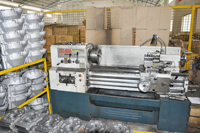What should we pay attention to when disassembling the car transmission?
1. First, remove the universal joint screw, so that the universal joint of the transmission and transmission shaft is separated; Then remove the clutch cover screw to separate the transmission and clutch; If it is a remote operated transmission, the operation arrangement and the transmission body will separate the transmission from the car.
2. Clean the oil sludge and dirt on the outside of the transmission, and pay attention to protect the front and rear axle heads.
3. Screw the oil drain plug, drain the lubricating oil in the transmission, and then screw the oil drain plug.
4. Find a clean and dust-free place, use to open things and copper bar, start to open the transmission. The disassembly sequence is usually: transmission cover, first shaft, second shaft, central shaft and reverse shaft.
5. When disassembling the parts, first look at the initial direction and orientation of the parts, and then disassemble them. If necessary, make records; The disassembled parts are arranged in order according to the order of disassembly, and the parts can be strung together by wire or iron wire when necessary; The gear can be set on the shaft according to the original direction and orientation to prevent wrong or missing installation.
6. All disassembled parts shall be clean and inspected accordingly, and those that cannot be used shall be replaced; The disassembled oil seal and gasket should not be used continuously and should be replaced.
7. Before the equipment, apply gear oil or engine oil to the bearings, oil seals, keyways on shafts, inner holes of gears and bearing holes of transmission case, and permeate the replaced paper pad with engine oil.

8. The equipment sequence is opposite to the disassembly sequence, that is, the parts removed later are installed first, so that all parts of the equipment are in the original position. During the equipment process, the cooperative parts should be rolled frequently, and the direction of the oil seal should be paid attention to, and there should be no damage.
9. Before the transmission cover of the equipment, check whether there are no missing parts, whether there is axial movement of each shaft and fixed gear, whether there is no missing paper pad everywhere, and whether each pair of meshing gears are meshed in the whole tooth width; Move the sliding gear by hand to see if it can move axially to full tooth width meshing; Roll a shaft by hand and try each gear separately. It should be able to roll smoothly without jamming. Add proper lubricating oil into the gearbox according to the rules.
10. Install and fix the fork to the corresponding fork shaft, and then install the fork shaft into the corresponding hole of the transmission cover. Pay attention to install the self-locking arrangement and interlock arrangement into the corresponding holes when shifting the fork shaft. When all the shift fork shafts are in place, put them in the neutral position, and the sliding gears in the transmission arrangement are also in the neutral position. Install the transmission cover on the transmission case. At this time, the shift fork happens to be put into the corresponding gear slot, install the connecting bolts, tighten the bolts according to the regular order and torque, and use the shift lever to engage in different gears, Check whether the gear can be smoothly engaged in turn. If it can not be engaged, you can quietly roll one axle back and forth by hand. If it still can not be engaged, you should remove the case cover for inspection.
11. After installation, the test run should be carried out. Each gear should be able to roll freely without oil leakage, oil leakage and jam. The appearance of jumping gear and disorderly gear is not allowed in any gear. Shifting should be simple and easy, without abnormal sound and overheating.
Article from:http://www.www.tbtea.cn
-
07-10
Why can transmission change speed and what kind of transmission?
Why can the transmission change speed?Why can the gearbox adjust the output torque and speed of the machine? It's the principle of gears and levers. There are many different gears in the gearbox. Through the combination of gears of different sizes, the adjustment of torque and speed can
-
07-10
Causes of transmission shifting
Causes of transmission shift skipping defect:l) Due to the excessive wear of the gear teeth of the variable speed gear, gear sleeve or synchronizer cone, a rudiment is formed along the direction of the tooth length, and an axial thrust is generated when the gear is meshed, which is also affe
-
07-10
Three types of transmission
There are three common types of automatic transmission: at, CVT, AMT and DSG. At that time, at was widely used, and at almost became the pronoun of automatic transmission.At is composed of hydraulic torque converter, planetary gear and hydraulic operation system, which ends the variable spee
-
07-09
Causes of transmission gear wear
Transmission gear often works under the condition of high speed, high load and constant alternating speed and load. In addition to the normal wear and tear of gears, there are also reasons such as poor quality of lubricating oil, poor lubrication conditions, improper driving operation, improper